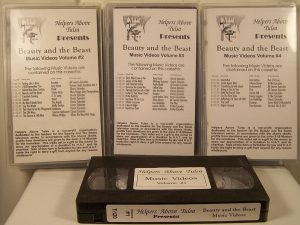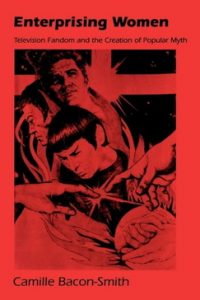
”Fan fiction is a way of the culture repairing the damage done in a system where contemporary myths are owned by corporations instead of owned by the folk.” (Henry Jenkins)
“[Fandom] takes the place of some of the functions of a church in a small town: A place where people come together, ostensibly to worship something. But really what’s happening is you’re forming a community. It’s less about what you’re worshiping and more about, “We have these interests in common.” Someone has a sick aunt and suddenly it’s about that, raising money to help her or sharing resources to make her life easier. That’s what it was about with The X-Files on the Internet.” (David Duchovny)
“People always ask me what I’m a fan of. And to me, it’s sort of like asking a punk rocker, ‘What are you a punk of?'” (Henry Jenkins)
In 1893, fans of Arthur Conan Doyle’s Sherlock Holmes stories took to the streets wearing black armbands in protest of the ‘death’ of the fictional detective. These Holmes enthusiasts were an early example of what is now called ‘fandom’ — groups of people who connect over their shared love for a work of fiction, sports team, celebrity, hobby, or other area of interest. In the early to mid twentieth-century, fans of science fiction (predominantly men) began forming clubs and holding conventions to discuss their shared enthusiasm (Bacon-Smith, 1992). One early convention was the World Science Fiction Convention (or Worldcon), which was first held in 1939 and has continued annually.
Out of science fiction fandom emerged media fandom. The original series of Star Trek is generally considered to be the source of the first modern media fandom, which took the form of fans connecting to one another by attending conventions and/or by creating and reading ‘zines’ containing art, poetry, stories, songs, and other forms of creative response to the series. Fans created the first Star Trek zine, Spockanalia, in 1967.

Notably, and unlike the science fiction fan communities from which they were splitting off, a large proportion of the fans involved in creating these communities were women. Factors which combined to create the conditions for female fans to connect with each other and take leadership in the newly-forming communities included broadcast media spreading the source material, increasing access to “technologies of reproduction” such as photocopiers and VCRs, the sexual revolution, and the women’s liberation movement. These factors facilitated the ability of women to connect with others not in their immediate geographic location, and to express their sexuality and discuss shared interests in spaces not overwhelmingly dominated by male judgments.
Similar fan communities began springing up around other media sources not long after they emerged for Star Trek. The earliest media fandoms predominantly surrounded science-fiction television shows such as Blake’s 7, but eventually spread to other genres and to other source materials such as movies. Within the large groups of people who enjoy consuming and/or discussing works of fiction, subsets which participate in the types of transformative activities popularized by Star Trek fans have persisted. While some fans engage with only a single work of fiction, many hold interests in multiple source materials simultaneously or move from one to another over time: being part of fandom is often more than being a fan of any particular work (Clerc, 1996). These fannish communities, which involve consuming or creating transformative works such as fanfiction, exist as a unique place for female-driven narratives and as a subculture.

Members of media fandom are not simply passive consumers of pop culture. Rather, they engage with the source material by producing their own content and sharing it with other fans through transformative works, a term for fan-created works which derives from the legal label used to describe such works under fair-use copyright law (the legal particulars of which are a matter of long-standing debate). ‘Fan fiction’, the most well-known category of transformative works, describes stories which are set in a particular fictional universe (that of Star Trek or Harry Potter or Star Wars, for example) and/or involve characters from that universe, but which are written by written by fans rather than official creators. Most fan fiction authors — for example, 90% of Star Trek fan writers in 1973 — are women (Coppa, 2006). Fan fiction is often categorized by emotional content — common genres include ‘angst’ and ‘hurt/comfort’ — or by the types of relationships it depicts: male/female pairings (‘het’), same-gender pairings (‘slash’, a term originating from Star Trek fanfiction which used ‘K/S’ to denote works which portrayed a romantic relationship between Kirk and Spock, as opposed to ‘K&S’ which was used to label works focusing on the pair’s friendship), or non-romantic-relationship-centric (‘gen’) (Bury, 2005). Other types of transformative works include fan videos (which originated with Kandy Fong, who used a slide projector and cassette tapes to play Star Trek images synced to music at fan conventions), filk music, and fan art.
Not everyone who is a fan of a particular work is part of the fandom subculture. ‘Fandom’ generally refers to the fans who actively associate with others who share their interests and/or participate in activities demonstrating their enthusiasm for the source material – that is, those who are part of participatory culture. Within the broader category of fandom exist subgroups, including the transformational fandom this page discusses, which involve a creative/productive element, as well as the distinct (but not mutually exclusive) category of ‘curative‘ or ‘affirmational‘ fandom, which describes the more male-dominated fan spaces which tend to glorify knowledge of the source material (e.g. memorizing trivia, collecting merchandise, etc.).

Fandom communities are diffuse networks that do not have an established hierarchy or a profit-making economy, and information about more specialized communities (e.g. smaller fan-run conventions which aren’t sanctioned by creators) is often passed along through word of mouth. Rather than something done for material gain, involvement in fandom becomes a sort of shared identity and a form of self-expression and connection with others (Bacon-Smith, 1992). When a fan violates the spirit of this gift economy (most infamously E.L. James, who changed the names in her Twilight fanfiction to publish it as an original work for money as Fifty Shades of Gray) or otherwise defy fannish customs, other fans may complain about their lack of knowledge of fandom history or adherence to the traditional fandom value system.
In the early 1990s, fan communities began to migrate to the Internet, where they have since expanded in numbers and fragmented along lines of genre, area of interest, and type of interaction with the source material. However, the Internet is frequently an unfriendly place for women, and broader fandom communities have historically been no exception. Large forums for the discussion of popular movies, for example, tend to be dominated by men, and many female fans, often facing harassment in these spaces, chose to create spaces of their own (Bury, 2005). Female-dominated fandom spaces have included the private e-mail lists of the 1990s, modern social networking websites such as LiveJournal and Tumblr, and fanfiction websites such as Fanfiction.net and Archive of Our Own. Popular and influential fandoms in the Internet age have included The X-Files, Buffy the Vampire Slayer, Harry Potter, Stargate Atlantis, and Twilight. The rise of the Internet has made fandom more global than it was in the mid twentieth century: though some fans do participate in the local fandom scenes of small conventions, clubs, etc., fans online can connect with others around the world.
“A conceptual space where women can come together and create — to investigate new forms for their art and for their living outside the restrictive boundaries men have placed on women’s public behavior…The creation of this art, the bending of popular culture artifacts — in some cases, popular culture icons — is a subversive act undertaken…under the very noses of husbands and bosses who would not approve, and children who should not be exposed to such acts of blatant civil disobedience.” (Camille Bacon-Smith)
Fannish identity can intersect with other aspects of a fan’s identity, particularly with regards to gender. One explanation for the strong gender correlation in fanfiction writing is that since men hold the majority of mass-media jobs and production power, women use fanfiction to express their own narratives and challenge the dominant culture. Fan fiction has tended to appeal to marginalized individuals such as women and racial minorities, who use their writing as a tool to express criticism of social and political inequalities (Hellekson and Busse, 2006). According to Henry Jenkins, “the largely female composition of media fandom reflects a historical split within the science fiction fan community between the traditionally male-dominated literary fans and the newer, more feminine style of media fandom” (1992:48). Through fan-fiction (primarily female) fans bring female experiences and perspectives into source texts which are generally written by and about men, and often challenge norms of gender and sexuality. Predominantly or exclusively female fandom spaces resist the normative order by refusing to accept the fan practices that male fans traditionally engage in (Bury, 2005).
“I adore the way fan fiction writers engage with and critique source texts, by manipulating them and breaking their rules. Some of it is straight-up homage, but a lot of [fan fiction] is really aggressive towards the source text. One tends to think of it as written by total fanboys and fangirls as a kind of worshipful act, but a lot of times you’ll read these stories and it’ll be like ‘What if Star Trek had an openly gay character on the bridge?’ And of course the point is that they don’t, and they wouldn’t, because they don’t have the balls, or they are beholden to their advertisers, or whatever. There’s a powerful critique, almost punk-like anger, being expressed there—which I find fascinating and interesting and cool.” (Lev Grossman)
Transformative works are often used to resist traditional narratives in ways other than gender dynamics. Since fanfiction writers do not need to worry about what is commercially acceptable or marketable, they can choose their methods and topics of writing more freely (Coppa, 2006). Fandom has also traditionally been a place for the exploration of social issues, particularly explorations of gender and sexuality which defy the dominant culture and traditional binaries (Jamison, 2006). One point of view suggests that the act of writing fan fiction is subversive regardless of the content of the story: “Fan fiction is philosophically opposed to hierarchy, property, and the dominance of one variant of a series over another variant” (Helleckson and Busse, 2006: 77). While some authors, such as J.K. Rowling and Stephenie Meyer, have welcomed fanfiction of their works, others, such as Anne Rice, have not, and Lucasfilm, which sent cease-and-desist letters to fanzines warning them not to publish Star Wars material containing “pornography, vulgarity, or explicit gore and violence” in the 1980s, shut down a slash fanfiction archive on copyright grounds as recently as 2001.
Trekkies (1997): A documentary featuring interviews with devoted fans of Star Trek, including Barbara Adams (the Whitewater juror who appeared in court wearing a Starfleet uniform).
Vidding (2008): A series of short documentaries about fanvids, discussing subjects such as vidding technology and the vidding community. Below is video on ‘Collaboration and Community’:
Starships by bironic: A multi-fandom fanvid incorporating video from over two dozen science fiction movies and TV shows, set to Nicki Minaj’s “Starships”.
Citizen Fan. A 2014 French documentary about fan culture, particularly fan fiction, fanzines, vidding, and cosplay. Watch here (click ‘UK’ for English subtitles).
“Zaphod Beeblebrox and Me.” A popular Hitchhiker’s Guide to the Galaxy-inspired filk written by Gregory Baker. Listen here (sung by Roberta Rogow).
Paula Smith, coiner of the common fanfiction term ‘Mary Sue,’ discusses fanfiction, early Star Trek fandom, and the ways in which fandom has changed since the early days of Trek fandom. Read here.
Francisca Coppa discusses the history of vidding (creating fan videos). Read here.
Henry Jenkins, author of Textual Poachers, discusses participation in and scholarly analysis of fan culture. Watch here.
 Bacon-Smith, Camille. 1992. Enterprising Women: Television Fandom and the Creation of Popular Myth. Philadelphia: University of Pennsylvania Press. An early study of the fans of Star Trek and other genre television shows with a focus on the female fanzine and fan fiction community.
Bacon-Smith, Camille. 1992. Enterprising Women: Television Fandom and the Creation of Popular Myth. Philadelphia: University of Pennsylvania Press. An early study of the fans of Star Trek and other genre television shows with a focus on the female fanzine and fan fiction community.
 Harris, Cheryl, and Alison Alexander. 1998. Theorizing Fandom: Fans, Subculture, and Identity. Cresskill, N.J.: Hampton Press. Examines the role of fandom in society by exploring themes such as gender, power, and social class.
Harris, Cheryl, and Alison Alexander. 1998. Theorizing Fandom: Fans, Subculture, and Identity. Cresskill, N.J.: Hampton Press. Examines the role of fandom in society by exploring themes such as gender, power, and social class.
 Jenkins, H. 1992. Textual Poachers: Television Fans & Participatory Culture. New York: Routledge. An ethnographic account of media fandom community, practices, and relationship to capitalism and mass media.
Jenkins, H. 1992. Textual Poachers: Television Fans & Participatory Culture. New York: Routledge. An ethnographic account of media fandom community, practices, and relationship to capitalism and mass media.
Clerc, Susan. 1996. “Estrogen Brigades and ‘Big Tits’ Threads: Media Fandom Online and Off.” In Wired Women: Gender and New Realities in Cyberspace, edited by Lynn Cherny and Elizabeth Reba Weise. Seattle, Wash.: Seal Press.
Coppa, Francisca. 2013. “An Archive of Our Own.” In Fic: Why Fanfiction Is Taking Over the World, edited by Anne Elizabeth Jamison. Dallas, Texas: BenBella Books, Inc.
Falzone, P. 2005. “The Final Frontier Is Queer: Aberrancy, Archetype and Audience Generated Folklore in K/S Slashfiction.” Western Folklore, 64(3/4), 243-261.
Hellekson, K. 2009. “A Fannish Field of Value: Online Fan Gift Culture.” Cinema Journal, 48(4), 113-118.
Woledge, Elizabeth. 2005. “From Slash to the Mainstream: Female Writers and Gender Blending Men.” Extrapolation 46(1):50-65.
Xiao, Fan. Feb. 12, 2023. ““We are snowflakes”: Minor transnationalism and the cultural resilience of slash fanfiction community in China.” Global Media and China 8(4), 490-505.
Deshler, Kira. Sep.24, 2023. “How Fandom is Still Shaping Pop Culture.” daily dot.
Fanlore: A wiki for the history of fan communities and activities.
Transformative Works and Cultures: An online-only peer-reviewed journal which publishes articles about transformative works, media studies, and the fan community
Books
Bury, Rhiannon. 2005. Cyberspaces of Their Own: Female Fandoms Online. New York: Peter Lang. An ethnographic study of two female internet communities (The X-Files fandom and Due South fandom) that investigates issues of identity, community, and space.
Gray, Jonathan (Jonathan Alan), Cornel Sandvoss, and C. Lee Harrington. 2007. Fandom: Identities and Communities in a Mediated World. New York: New York University Press. A collection of essays examining fandom spaces, fandom around the world, the impact of new technologies, and the legal and historical contexts of fan activity.
Hellekson, Karen, and Kristina Busse. 2006. Fan Fiction and Fan Communities in the Age of the Internet: New Essays. Jefferson, N.C.: McFarland & Co. A collection of essays on modern Internet fan fiction communities, covering topics including community, sexuality, and the construction of narratives.
Jamison, Anne Elizabeth. 2013. Fic: Why Fanfiction Is Taking Over the World. Dallas, Texas: BenBella Books, Inc. Explores the history and culture of fan fiction writing, and includes interviews with and essays by fan writers, readers, and scholars.
Articles
Busse, Kristina. 2013. “Geek Hierarchies, Boundary Policing, and the Gendering of the Good Fan.” Journal of Audience and Reception Studies, 10(1), 73-91.
Byrd, Patricia. 1978. “Star Trek Lives: Trekker Slang.” American Speech, 53(1), 52-58
Turk, Tisha. 2014. “Fan Work: Labor, Worth, and Participation in Fandom’s Gift Economy.” Transformative Works and Cultures (15).
Byrne, Lindsey. 2016. “Transformative Media Fandom”. Subcultures and Sociology. Edited Feb. 7, 2024.